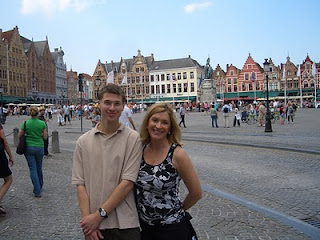 It has been a while since I have had time to update this blog. After completing my internship in Romania, I traveled to Krakow for an intensive Polish language program at Jagiellonian University. Shortly after arrival there, our entire group was ushered into one of the university’s oldest lecture halls for the official inauguration of the program. As part of the opening festivities the U.S. Consul General addressed me and my peers.
It has been a while since I have had time to update this blog. After completing my internship in Romania, I traveled to Krakow for an intensive Polish language program at Jagiellonian University. Shortly after arrival there, our entire group was ushered into one of the university’s oldest lecture halls for the official inauguration of the program. As part of the opening festivities the U.S. Consul General addressed me and my peers.“Let me tell you the Polish language is tough,” the consul warned us. He added that our curriculum was so intense, that between study, sleep, and fun, there were only enough hours in the day for us to “pick any two.” At the time I thought he was joking, but as I soon found out his words rang true.
My first wake up call came during the placement test, which was right after the inauguration. I already spoke a good amount of Polish and expected that I would be placed in one of the intermediate levels. So I was disappointed when the results came out, to find that I had been placed one of the beginning levels, along with many other non- native speakers, many of whom had taken four semesters of university level Polish in the US. Despite this, the subject matter on the first day of class confirmed suspicions that I had been placed too low. I began to attempt to move to a higher level. While at first my efforts met with little success, after two days I was finally granted grudging permission to move to the intermediate level.
My new level proved to be very challenging. In addition to this I decided to further test my abilities by enrolling in a college level course on Polish history, taught in Polish, which I finished with an A.
On the weekends I managed to have a life outside the course. I greatly enjoyed hiking in the Tatarskie mountains, and visiting my roommates’ families in the small town of Nowa Sarzynna. My weekend trip to Ukraine proved to me that while Poland’s neighbor is beautiful, it can also be somewhat dangerous. I narrowly avoided being ripped off by the local gangsters. The highlight of my trip was finally getting to meet my own Polish family in person. While the courses proved instructive, I have to say that I learned the most, simply visiting with my Polish friends and family.

The final day of the program was also my birthday. My friends and I prepared for a final night on the town before going our separate ways. That evening the management called one final meeting of the students in the Stolowka, the dining hall in the building where we stayed. It quickly became apparent the purpose of this meeting was to give out awards. I had only been grudgingly admitted into my level, and was not expecting much from this ceremony. So, I was shocked when I heard my name. The president of the program recognized me for the highest marks and outstanding achievement on the intermediate level.
I came to Poland already knowing that I had an affinity for its people and culture. My experiences this summer have strengthened my determination to return next summer to continue my studies in Krakow. I hope to combine this with a business internship in May and June. I am currently on an accelerated track to complete my business degree by June 2012 and then begin the adventure of graduate school or a job in Eastern Europe.




































